Occultism and the Living World (07)

Mystics & Artist-Prophets:

.
.
Superpowers – The Real Madame Web & Theosophy: The timeline of 120 years, following from the 1500s to the beginning of the 30-year war, was a constant effort in parts of Europe to change society forward into a magical revolution. Europe of the 11th and 12th centuries was ruled by scholastic rationalism; witchcraft was unknown and was merely a curiosity or folktale for some. From the 15th and 16th centuries, this tremendous proliferation of magical thinking evolved into systems of magical ideas. Along with it came social hysterias relating to the interest in these magical ideas like witchcraft, alchemy, conjuring, and magic.
After Rosicrucianism came, a new resurgence of occultism emerged in the New World [New Atlantis]. As we covered in the last post, it was supposed to be a nation where the mystical and metaphysical would garner a new identity—further propelled through several secret societies [like Freemasonry] pursuing a similar scope of the Rose and the Cross. It would be an interpolation of the landscape and a mystical and metaphysical understanding. What is a standard fact is that there was “some kind” of esoteric doctrine that likely had a role in its foundation within the British colonies, which became the United States. Then, the Puritans arrived, along with Protestant Christianity, which would fracture into denominations across the East of America. From the early 16th century to independence in 1776, Freemasonry became less secret as an anti-masonic movement that would sweep the nation by the 1820s.
We must remind ourselves Rosicrucianism embodies the ideal of protestant-Christianity alongside a parallel ideologue of [pseudo] science like [the solar martyr] Bruno’s heliocentric idea. This pseudo-understanding of the cosmos would dominate the Western world and introduce other pseudo-ideas like evolution. By the early 1870s, New York and most of the country except maybe for the Bible belt, along with a rising movement of spiritualism and Eastern mysticism [thanks to theosophy], most had accepted this pseudo-materialistic understanding.
In 1873, in rural New York, two sisters, Lea and Margret Fox, declared that they contacted spirits beyond the grave by using the technique called séance. Those groups became more popular when a Russian-born woman by the name of Madam Blavatsky arrived in New York and became the figurehead of the spiritualism movement. Later, she became a leading authority in ancient occult secrets. She grew up in an occult world where her father had already established a collection of occult libraries. She saw the connections between different cultures and spiritual teachings and was tempted to correct the errors in Christianity by bringing in mysticism and spirituality from other cultures.
She popularised occultism into a worldwide movement when she founded the Theosophical Society [an esoteric spiritual organisation Blavatsky started in 1875 in New York]. Several members of the society would continue the work on occultism on their own, authoring their works. Blavatsky was born in Ukraine in 1831 into a family of nobility, and at around 17/18, she ran away from an unconsummated marriage with an older man. For the next twenty years, she wandered the world in search of mystic knowledge. Before that, she was fascinated by the occult library that her great-grandfather had. Her great-grandfather was part of a secret society called Russian Freemasonry in the late 18th century. They had a political side, a transformative vision of Europe, and a utopian progressive society. It was a group preoccupied with overthrowing the Church and the monarchy of the time. She was fascinated by the secret group having secret knowledge, these masonic laws and mysterious high-ranking figures having a hand in society.
As a child, Blavatsky claimed she had strange otherworldly experiences like visions, encounters with spirits, and memories of past lives. On some occasions, these types of spirits acted as guardians. There was a time as a child when she put her own life in danger so that these spirits would save her life from these possible accidents that would have otherwise killed her. She didn’t understand what these spirits were until she was an adult. By then, she recognised that these spirits were not spirits but the actions of these psyche Hindu masters. She would later travel around the world trying to seek these masters out.
She later met these mysterious masters when she visited India and saw them in person. Upon getting to know them, she referred to them by their name, Morya and Koot Hoomi. These guys were said to teach her psychic abilities. She stayed in Tibet, studying various spiritual practices and mastering her secret powers. By this time, a lot of controversy surrounded these figures, and Blavatsky herself was fond of producing such phenomena. It is a story in which she had visited her father and brother before settling in New York; her brother was a university student and was sceptical, and rationale he doubted her ability. As a result, Blavatsky points at the coffee table and says, “I can make that so heavy that you won’t be able to lift it” – her brother goes over and picks it up very easily. Then she stared at it with concentration and said, “No” Her brother tried to lift it but was unable to, neither his friend could lift it, both at the same time couldn’t lift it – then she let it go, suddenly it jumped into the air, her brother almost breaking his arm in doing so.
At this time, ‘spiritualism’ had become a type of craze both in Europe and the United States in the late 1840s, which carried on to the early 1870s. Blavatsky, however, stood apart from that as she was more of a magician than a medium. She had control of things; she wasn’t passively being used as a voice from the spirits of the other side who would come into the mediums and speak to them. She was commanding the spirits.
She often described this other self as a vivid encounter with her other [or spiritual twin or possession] when she was living with her companion Colonel Olcott, where he described watching her as she was working – and at times claimed that her appearance would change/morph in real-time, changes, from hair to face. Suggests that she had a second personality that she could somehow invoke or allow to manifest in her, and it would write some of the passages. A case study suggested she had used quotes from famous books to which she had no physical access. The story says that she would access these information quotes by gazing at her concentration at a distance – meaning she would see the passages in the astral plane. A technological equivalence to the World Wide Web, but is instead ethereal. These supposed spiritual perceptions were later fact-checked by someone accessing the Vatican Library; her quotes did indeed match. Meaning there is confirmation regarding pre-cognition or psyche abilities.
When we discuss a technological equivalence to the World Wide Web, we are talking about something ethereal, similar to the ether, but closer to the scientific language, which is the magnetic field and its ethereal parallel akashic records. These are where your stories in history are archived, and this field is visually symbolic of the spider’s Web and its weaving. The spider or the spider-man represents Kwaku Anansi [Akan folklore], who connects to the history or his stories by accessing/weaving webs [a.k.a as magnetic fields].
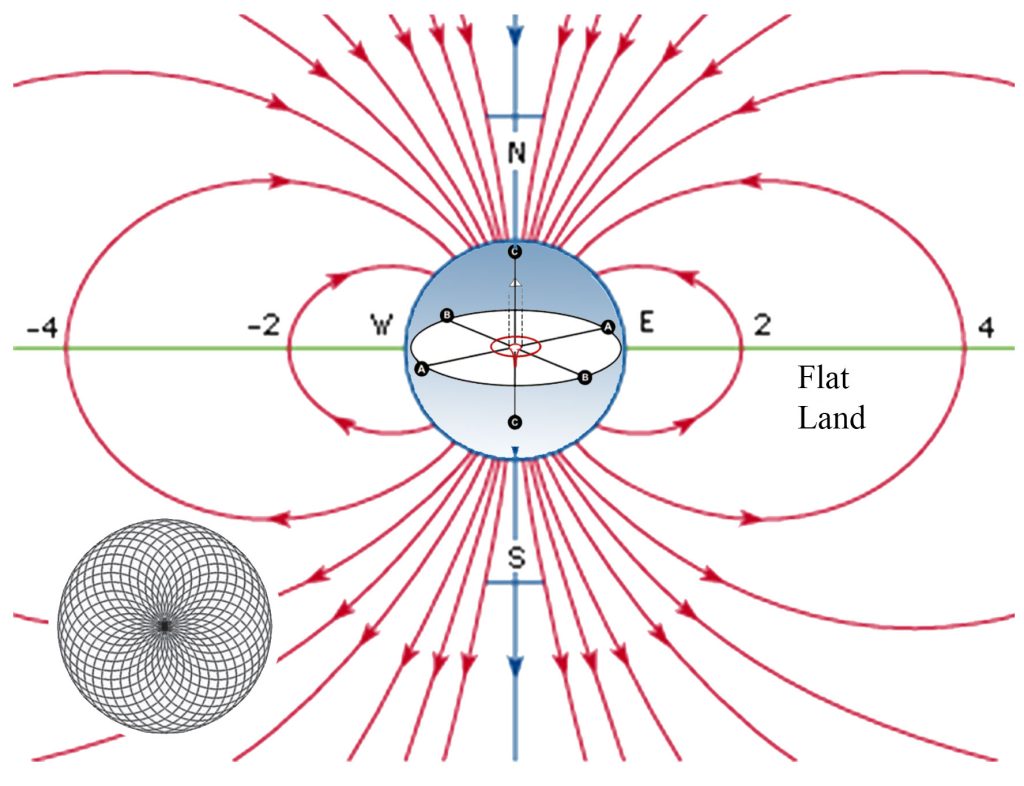
Given that understanding, this makes Madame Blavatsky, Madame Web—the druids say spiders are spiritual guides. In the Spider-Man comics and animations, Madame Webguides Spider-Man to his many different multiverse versions of his spider self.
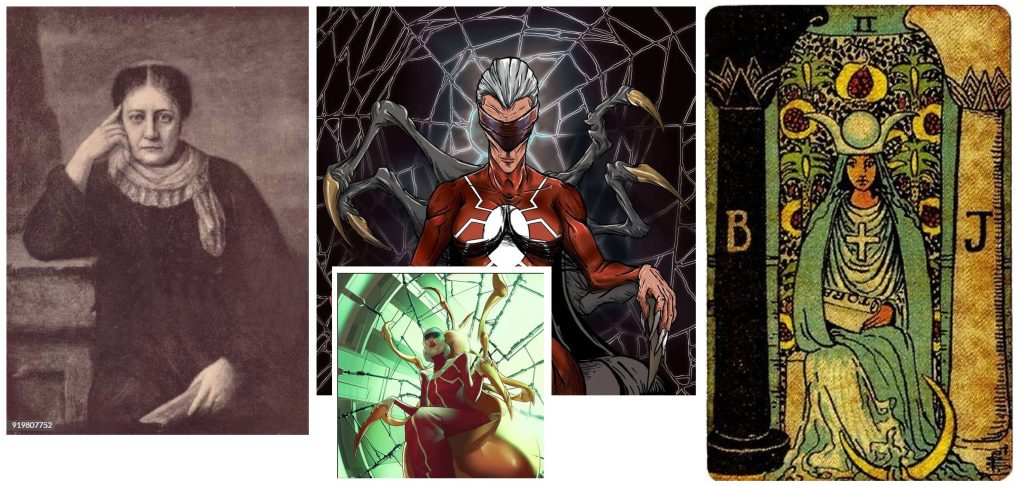
Weaving spiders goes back to an old Greek myth of an old woman weaver named Arachne who disrespected Athena/Minerva, the goddess of weaving, and failed to acknowledge her – her weaving skills came from the goddess and not from her power. And so Athena/Minerva turned her into a spider as punishment for being Argonaut. Her descendants would have to weave webs forever because she thought she was good at it. This all means or signifies – not to challenge the gods.
Christian fundamentalist conspiracy theorist [CFCT] groups have positioned theosophy [the secret doctrine] and Blavatsky as part of an esoteric agenda associated with fascism and Nazism. These tropes are often superficial, shallow, and sensational, and they’re usually uninformed of the full contextualisation and comprehension regarding the secret doctrine. There is confusion surrounding the eternal recurrence of the swastika symbol that the right-wing fascists took from her. The truth, as is often the case, is more complicated. Jorg Lanz von Liebenfels and his debased version of theosophy, which is “Ariosophy”, stole the symbol and turned it into something else. She was introducing an ancient symbol to the development of humanity, the Vedic notion of eternal recurrence. She didn’t see it as having any ethnic connotation; she didn’t see it as belonging to any programme of nationalism, and she expressed no such idea at any point in the secret doctrine.
Even though she was very knowledgeable about occult traditions, her other goal was to create an international brotherhood of humanity. It was a multi-ethnic/racial, multi-faith, pluralistic, and tolerant brotherhood of people, paralleling democratic and liberal attitudes. This came from her intrigue towards her great-grandfather and his Freemasonic roots. A utopian ideal that was spurred by a sense of romanticism, which is a far cry from Masonry today, where it’s about secret agendas, demonic/watcher worship, corporatism, hierarchies and power.
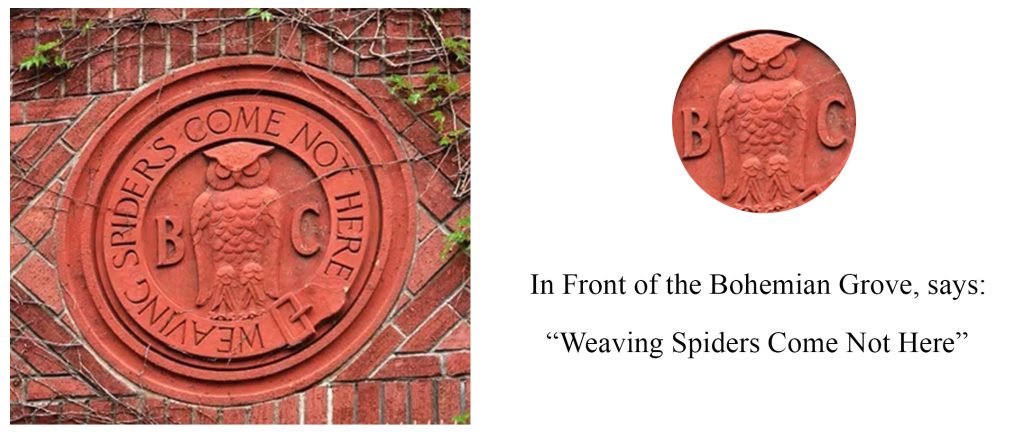
While she had relatives who could tie her into Masonry, she was clearly never part of that group—as her ambition was more about creating an open brotherhood for everyone. Madame Blavatsky/Web is a weaver, and she’s not allowed to be part of the group. The Greek Owl of Athena is a symbol of wisdom. The Romans describe Athena as the Owl of Minerva. There are steps towards the initiation process; Minerva represents the first step for the recruits.
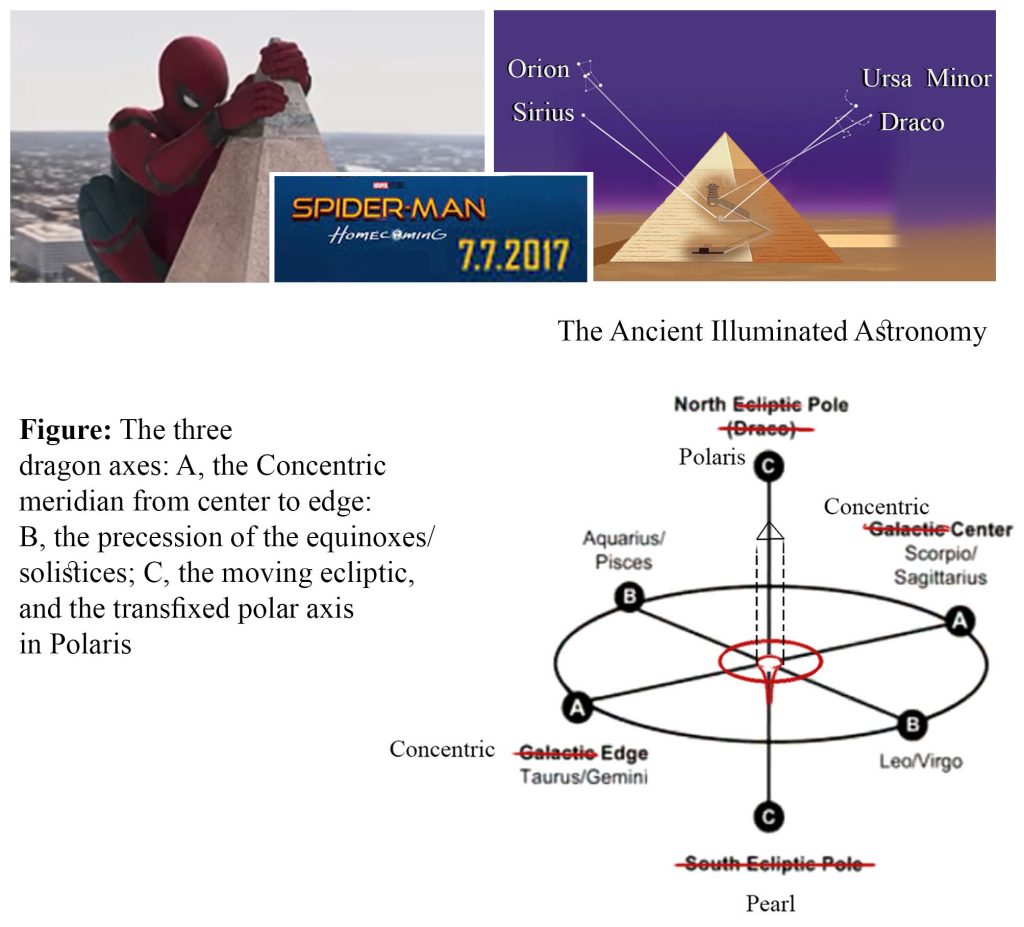
Spider-man Homecoming was released on 7.7.2017 – the significance of the number seven is no coincidence as it signifies the Greek deity Athena and the Roman deity Minerva, both goddesses of war and city protectors. We have Spider-Man on top of the Obelisk and capstone. This is a symbolic split between the Orion Pyramids and the North Mountain. It’s combination symbol for the great Tree that was once located at the North Mountain centre, where the centre of the magnetic fields radiates. It also represents other pyramids, such as the one found in Egypt. Researchers have claimed these pyramids were set out to be built with links to either cosmic stars or relevant lay-lines.
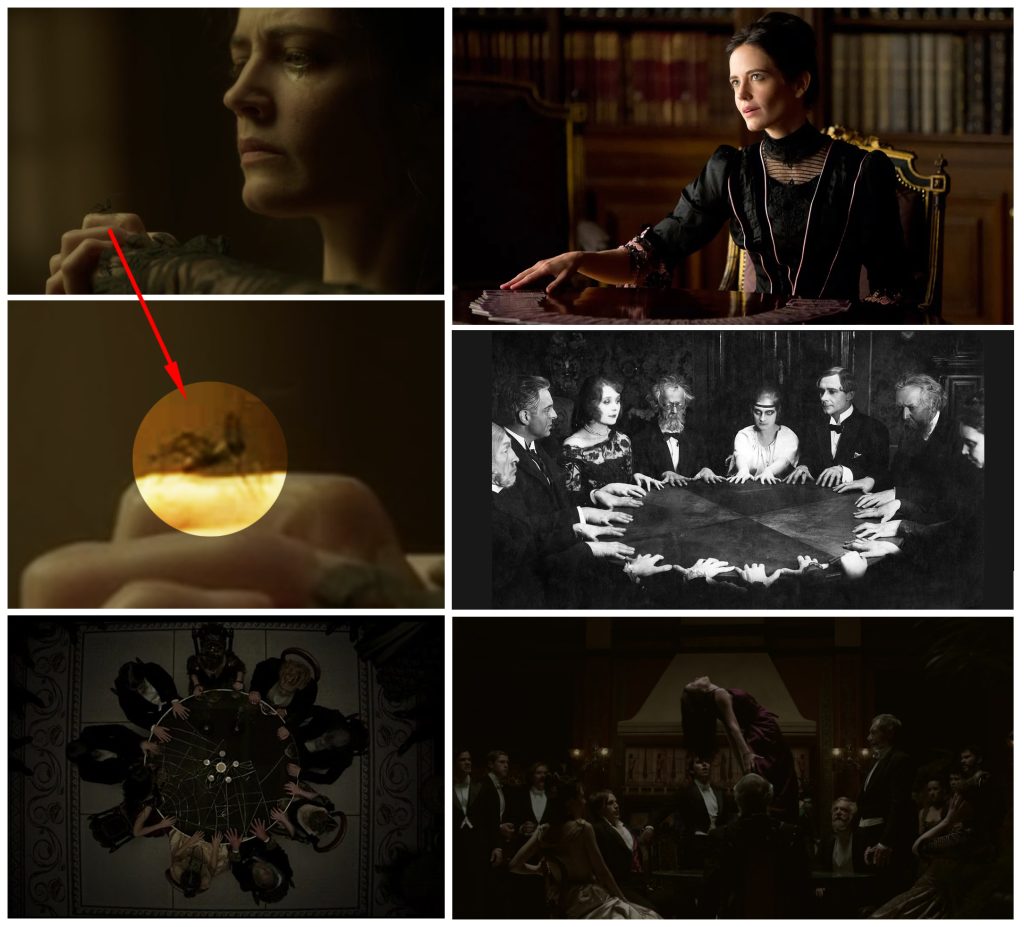
Eva Green plays Vanessa Ives, a narrow but more attractive complement to Blavatsky; her portrayal of the Madame and the aesthetics of spiritualism of the 18th century is decent enough. As Ives clasps the spider in her hand, you can see the spider motif, a potent symbolic spider reference for the weaver.
In Post (02) of this thesis collection, we emphasise that Egyptian emblems of Throne, Yan, and Us are also Thanus/Thanos, a Titan god of war who travels in a Q-ship. Thanus/Thanos is Ra with the glove on and Yan without. The number 17, as we know, is the numerical signifier for ‘Q’, which is also the deity for Horus [son of Osiris] or Ra, although Ra is equivalent to Yahweh, creator of the worlds. Bruno was executed in a ritual death on the 17th on ‘Q’ – where Q is the signifier for Horus, and the death ritual is astro-theologically charged. It’s an Osiris/Christ sacrifice of death. Bruno is a solar martyr for Q – he is also a placeholder for the Sun, and the Sun is the first light we see in the Horizon because the Sun moves across the Sky. In alchemy, gold/sol/sun is a circle with a dot in the middle connected to the eye’s symbology. Secret Society Groups put the eye in the middle of the Triangle instead of a circle, changing the dynamic or craft [more on this later].
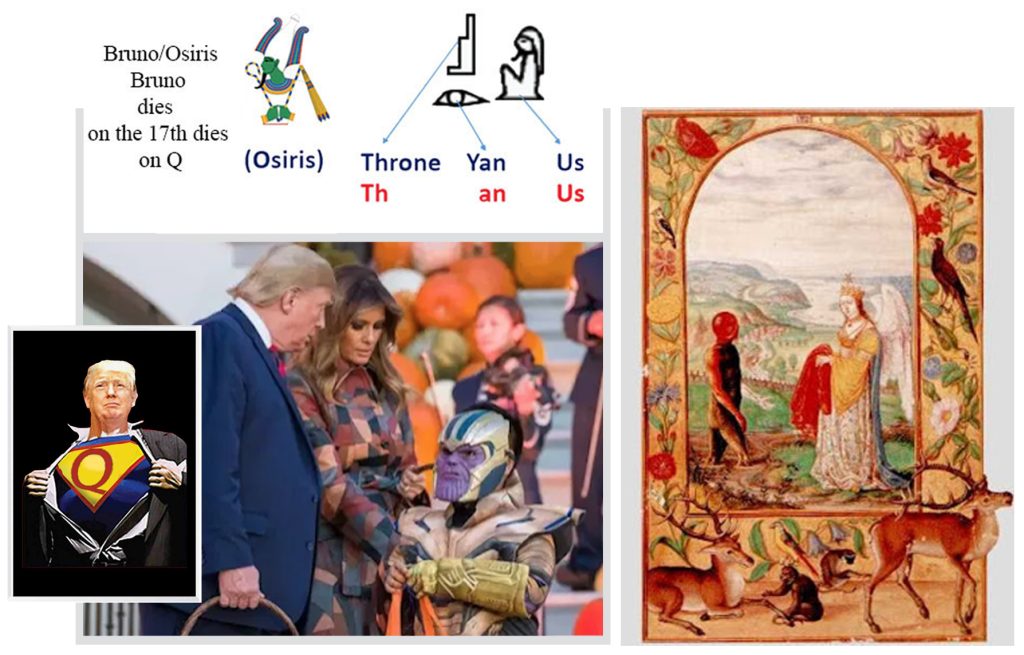
Trump is a Qanon mythological figure for racist conservative/republicans and Maga/Nazi sympathisers [with the vast majority of them applying for police enforcement roles and tend never to get vetted properly]; he was the clown or the fool in 2016, a joker who plays on the gullibility of Middle America’s intelligence with his Trump Card, which impart himself as heroic figure that will bring down an oligarch while all awhile is part of the same secret establishment. Today, he embodies the clown and the martyr, and when we look into the origins of the joker/clown. The joker started as the red hood reminiscent of the Rubedo from Alchemical iconography. Of course, Trump wears his famous red hat off (hat-red/hatred).
Rubedo is a Latin word meaning redness that alchemists adopted to define this fourth and final major stage in their magnum opus: the Red Sulfur, the Red Stone, the Red Elixir, and the Philosopher’s Stone. The gold and the philosopher’s stone were associated with red, as Rubedo signalled alchemical success and the end of the great work. Jung understood this idea when he suggested that the living dream state is insufficient. Jung writes, “In the state of ‘whiteness’, one does not live in the true sense of the word. It is a sort of abstract, ideal state. To make it come alive, it must have ‘blood,’ it must have what the alchemists called the Rubedo, the ‘redness’ of life. Rubedo, then, might be described as a permanent psycho-spiritual shift within the client or individual involving the appearance of objectively sensed truths. The most important relates to the relationship between the inner and outer planes, between microcosm and macrocosm or mind and matter.
As a result, an understanding of the Rubedo speaks to the functions of the Akashic Records, where objectively sensed truths must match an ethereal substantiation of facts. Blavatsky writes about life forms leaving permanent impressions we call Akasha. There is this infinitude of impressions or records like accessible photographic plates or thumbprints that are accessible as the Akashic records. Akashic Records come from Blavatsky; she mentions it in Isis Unveiled. Akasha is these ethereal substances that permeate and enter the material existence and people’s lives; it’s an ancient Vedic concept. Blavatsky says:
| It is not the physical organisms that remain in status quo least of all there psychical principals during the great cosmic or even solar cataclysms, but only Akashic or astral photographs. –Blavatsky, Isis unveiled |
.
Theosophy introduced a blend of Western and Eastern mysticism, such as Buddhism, which laid the groundwork for what is now known as the New Age movement. This spiritual movement gained popularity in various countries and cities. The Tibetan Book of the Dead, a widely known spiritual text, was compiled by Evans Wentz, a theosophist. Blavatsky’s goal was to bring hermetic philosophy and understanding to the materialistic West and demonstrate the reality of phenomena that occur at séances and spiritualist gatherings. She aimed to explain that these phenomena are not caused by the spirits of the dead but rather by lingering remnants or “shells” of low-level spirits unable to move on, which echo the final events of their lives.
She had envisioned uniting her type of occult vision with the new ideas of evolution and science [which at the time was still radical]. As a result, modern times allowed the wrong aspect of evolution, which is the majority, to have a mystic-rational legitimacy. Perhaps this was a bad choice of Blavatsky’s as overlapping mysticism with science would instil incoherency; it can go two ways: one: dogmatic rationalism [either materialistic or religious] or two: damaging cults of personalities or self-annihilation. Her overall doctrine, however, was still very different to modern materialism.
Evolution regarding change and process intertwined with occult traditions, examined in the spirits upon death where spirits/souls do not wait in heaven. Our spirit/souls carry on and transform into evolutionary changes – every living thing is part of this vast cosmic universal state of processes. What she was revealing in Isis regarding evolution was adaptive behaviours, which we discussed in the first post of this thesis collection. Moreover, in both volumes of ‘The Secret Doctrine,” she contrasted the science of her time with her writings. She knew what aspects of secret doctrines matched the science of the time and what factors they didn’t. Mainly around the field of physics and less with hyperrealism of [Bruno’s] space cosmos. Also the fundamental principles of quantum physics can be traced back to the teachings found in the secret doctrines.
She authored two massive books, ‘Isis Unveiled’ and ‘Secret Doctrines’, which are the secret teachings of the Eastern Brotherhood, the mystery schools (cults) of initiations, and she altered the spiritual landscape of Western civilizations by introducing those concepts. She pioneered ideas of Eastern esotericism into the West; she focused on the similarities between Christianity and Hinduism, Buddhism and other spiritual traditions, arguing that there is, in fact, a tradition that underlies all spiritual faiths in the world.
She regarded her work as a spiritual science and made connections between recent scientific advancements and occult beliefs. She promoted the ancient Eastern mystical view that the world’s essential nature was not Matter but Energy, which foreshadowed the discovery of modern physics. She also revived the Eastern beliefs of reincarnation and karma; by this time, she acquired an occult following, which, in turn, led her to launch the Theosophy Society. The term she coined (Theosophy) comes from two words: Theos (God) and Sophia (Wisdom); the society was about teaching divine wisdom. She would then be heralded as the Mother of the New Age.
Blavatsky rose to fame and garnered charisma but ultimately fell victim to her own success. As she became more successful, séances became increasingly popular, and she felt that such events had a sense of charlatan appeal. Blavatsky wanted to distance herself from that image. However, in the end, she was accused of the very thing she was trying to fight against. She was caught faking a séance event by using spring-loaded devices above her chamber, which investigators uncovered. This revelation tainted Blavatsky’s works both before and after her death with fraud. Despite this, Blavatsky still has devoted followers due to her ground-breaking work in synthesising Eastern and Western spirituality and pushing the boundaries of occult history.
Superpowers – Theosophy & its Influence on Pop Culture: Theosophy was a movement that arose from the rise of spiritualism popularised by Blavatsky and when Blavatsky made her way to New York. After spending a while in New York, she returned to India. Afterwards, Theosophy branched out to other institutions; Steiner formed anthroposophy; he also formed a private school called Waldorf, and then there was Lucia’s Trust, formed by Alice Baily. By this time, we are in the 1920s and 1930s. This is where pulp magazines started making their way through numerous printing distributions.
Pulp magazines were short stories printed on cheap paper. They featured superheroes like the Shadow, considered a prototype of Batman, and Doc Savage. Instead of deriving their abilities from science, these characters drew their powers from the occult. The Shadow travelled to an occult land to learn from initiates and masters, where he honed his psychic abilities. He also journeyed to the occult mountains of China to learn from Zen warriors and monks, studying their fighting style and spiritual philosophy. This story arc is similar to the one in “Batman Begins,” where Bruce Wayne is mentored by Ra’s al Ghul, an intelligent warrior, Eastern mystic and supernatural practitioner.
This desire to explore the exotic and harness its power is fundamental to empire building, with its pursuit of power and immortality. It arises from a fear of death, whether personal or the death of an empire. These early pulp stories from authors like Burroughs and Lovecraft influenced future storytellers. They drew inspiration from occult ideas associated with Lord Bruce. He was driven by a masonic directive based on the belief that Enoch was the first Mason, aiming to establish a new mythos centred on Enoch [read post 36]. Edgar Burroughs’ Vril book commonly explores the theme of the coming race, mirroring Enoch’s depiction of the Watchers in Atlantean mythology.
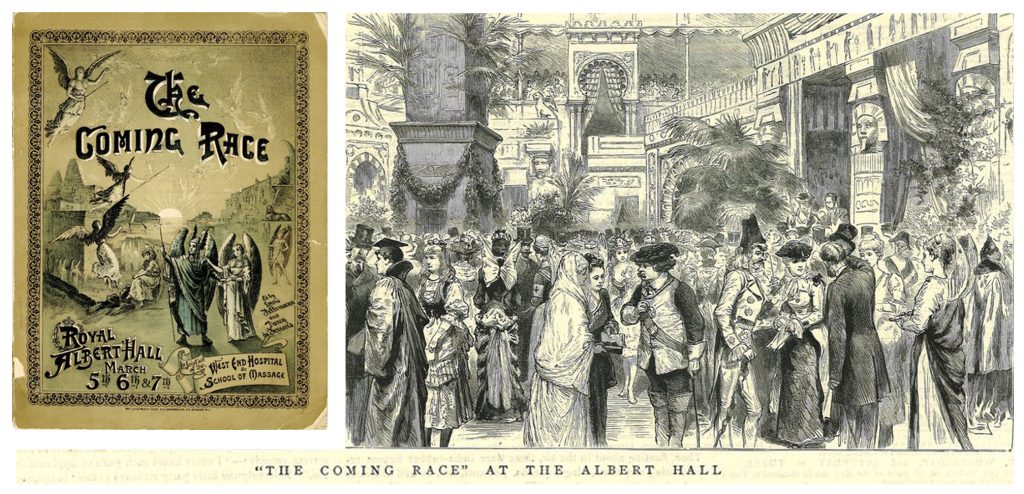
The book was so popular that in 1871, it led to a significant event-the first science fiction convention, reminiscent of our modern comic con. This convention, known as Vril-Ya Basaar and Fete, was held at the Royal Albert Hall. When theosophy branched out in the 1930s from Steiner to Bailey, a new term emerged to distinguish this evolved form of theosophy from its predecessor neo-theosophy, expounded by Besant. Bailey, however, distinguished herself by claiming that the Watchers were the truly good guys as opposed to the group of Angels Michael led. The question arises whether other personalities or elites of the empire who had a hand in progressing civilization were part of that worship to begin with. Given Bailey’s positioning herself to ally with fallen angels, it birthed the modern conspiracy theorists’ disposition of Luciferianism and, to some extent, Satanism.
Was this the new spark [or the beginning] of worshipping dark forces, where they would shed their mystical, metaphysical, transcendental, Protestant, and Rosicrucianism enlightenment heritage by adopting a bargain with the fallen ones that would coincide with technology and power? Not entirely, as these pagan worships tie back to medieval Rome alongside many sectarian viewpoints. Presuppositions that you may find in Mithraism regarding rituals, sex, psychedelics, and astrology. Where Mithra/Perseus is destined to escape “time” parallels and expounded later through Rosicrucianism.
Rosicrucian group’s framework is about believing that they were the divine spark in this divine Monad and by contacting the Angels [Kabala] with the hermetic theurgy and through the alchemical and imperial process alongside the understanding of the symbolic scripture – they can then gain knowledge to move closer to the divine one or essence. Even so, at the beginning of the sixteenth century, when Europe marvelled over cryptic manuscripts produced by the Rosicrucians, an “invisible college” of adepts who extolled mysticism and higher learning while prophesying the dawn of a new era of education and enlightenment. There is a question about whether a secret fraternity of Rosicrucians actually existed.
There is no doubt, however, that gaining (metaphysical) experience is separated through personal experience rather than being in a cult. Hence, its ideology sees itself as being separate from the papacy. It saw itself as purely neo-plutonic and with a focus on the Monad. It did away with superstition but kept rationalism, and by the Enlightenment era, it became about the blending of rationalism and superstition. This garnered the interest of former theosophist members like Baily and inspired personalities like Lavey and Crowley that invoked interest from secret cults (of Hollywood Babylon) and celebrities.
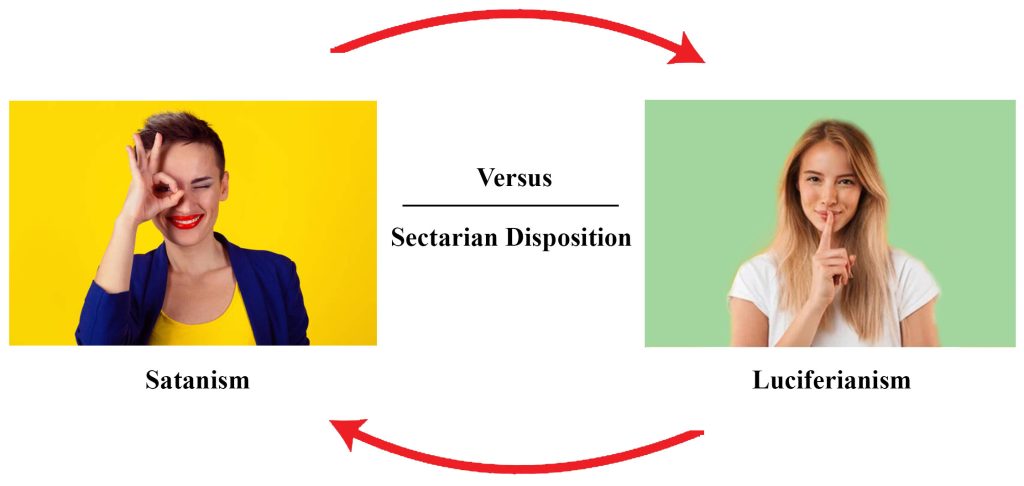
We must also remind ourselves of the clear difference between Satanism and Luciferianism; the comparison is as different as oil and water. Both Satan and Lucifer act as an archetype, and it’s easier to see that way as opposed to the other in regard to a culture where popular themes like good and evil have a direct relation to our esoteric notions of angels of light versus angels fallen, which are depicted in allegories or stories. At the same time, old cults from the past to the present have a modern leaning that firmly believes these myths are literal events. We’ve established that both Satan and Lucifer are true personal entities comprised of simultaneously accepting the rational and irrational together, and on this occasion, it’s essential to be divisive. The source of doubt runs both ways as we don’t completely know what comes after death through the pure and instrumental; the same can be said about god-like beings.
Satanism is viewed in two general terms: one as theistic-Satanism and two as atheistic-Satanism. The difference between the two is one [theistic] worships Satan as an actual being while the other [atheistic] comes from Lavey, who contrasted and dismissed Satan as an actual being but instead sees Satan as merely a symbol for what their faith encourages. He wrote a book ‘The Satanic Bible’ which started a cult religious movement that focused on the flesh, the mundane and the carnal. They reject religious Dogma [especially Christianity]. He saw it as hypocritical. They embrace individualistic desires, animalistic instincts, and personal pleasures. To them, Satan is not a real being, and all the symbols associated with Satanism are about individual empowerment and being an adversary to Christianity [or God].
LaVeyan Satanism embraces magic only on a psychological, theatrical or symbolic level rather than on a mystical level of the supernatural. The rituals described in his book serve as psycho-dramas to help individuals overcome psychological barriers and tap into their personal power. Inherently, it is not [real] magic and is more materialistic-magic that embodies two mode types: lesser-magic and greater-magic. Lesser magic is about psychological manipulation and personal charisma, while greater magic serves as a ritualistic form of self-therapy. Helping practitioners to focus their will and achieve their desires [self-help with theatrics as a tool rather than something supernatural].
In general, this type of [safe-space] Atheistic Satanism grew in popularity among current culture, from heavy metal/emo/goth music to villainous adversarial archetypal comic characters. What was once a steadfast ideological pole for neo-atheism, a movement inside it grew and evolved into young hipsters who are atheists evolving into Atheistic-Satanism? As a result, the kind of backlash that came afterwards in the guise of Satanic Panic not only reinforced the populace of Christianity’s ignorance typically of the symbol that lay before them. It also made people aware outside of their circle of ignorance that a joke always hinges between the consequences of government and that swing states and ignorance hold a lot of deciding power. Unsurprisingly, someone like Trump will come along as a clown in a presidency suit, taking advantage of this ignorance – a grifting opportunity made available. On the awareness that demoralisation with conspiracy theory [is a potent mix – and to the point] will garner followers following him to a dystopian end of the world.
The moral panic [from mob rule Christians] that ensues the satanic panic aggression on [safe] Satanism rebellious and adversarial nature towards Christianity – is really towards [elite] people(s) who are creeps, losers, perverts and rich weirdos obsessed with the flesh and sensual pleasures. The higher upper echelon of elite [secret] society is unlikely to admire such debauchery. One assumes there are levels of degrees, and those who partake in these sex ritual parties are beneath them and grotesque. Yet we are still differentiating notions of rituals and sacrifices throughout history, from old state cults to the modern utilisation of false flags and hoaxes that have ritual death surrounding them. Then one labelled towards atheistic-Satanism. However, both Lavey and Crowley were instigators or inspirations for the kind of carnal flesh these celebrities engage in. Action or neutralisation on such a debasement on the [higher-ups] name is apparent. Take, for instance, Epstein seen with Trump and his island of underage pleasures – alongside celebrities like Diddy.
There is really no Satan figure or lore to follow. He does get mentioned in the Bible as this opposing figure, and there are aspects of this figure in the Babylonian writings of demonology that came to light during the Crusades. All of these mentions are light in substance. There is no real satanic lord to follow. There isn’t anything there other than a Christian fundamentalist Tulpa or a Satanist symbol to garner cult ideology around.
Theistic Satanism, a belief in a literal meta-physical being called Satan, is apparent among Christian normies and also among high elite secret societies. We discussed it in the last post surrounding the eye symbol in the middle of the triangle on top of the unfinished pyramid. To the dismay of traditional Christians, it’s a fundamental existential and intellectual problem about Jehovah as a creator-God. As they are [subconsciously] praying frailty and worship the same deity – the creator-God is often depicted as Satanic, especially in the writings of John. The text discusses different interpretations of the depiction of God in the Hebrew Bible. It points out that some interpretations suggest that the creator God in the Hebrew Bible is portrayed as inferior or even evil, with some ideas surrounding a personified evil figure, sometimes referred to as Satan, being attached to the creator God. This leads to the portrayal of a very satanic creator god in the Apocryphon of John. This means all the uproar, protest, and panic from fundamentalist Christians are made redundant; however, to their ignorance, their protest is towards something they manifested as a Tulpa, something different entirely.
Traditional Christians, both Catholic and Protestant, ignore this Gnostic summation, and they have a clear mindset that Satan is not the creator-God, and if they can’t prove it. They will manifest this adversary figure. To make believe or manifest a deity to separate it from esoteric scripture is as equal [or an antithesis] to believing that the Satanic Deity is a symbol only. One juxtaposes the Creator-God outside of its true self, like in the analogy that promotes a true north in regards to the north itself in a heliocentric Globe. This is a modern explanation for the wobble that preceded the precession through observation by stargazers throughout millennia, which is false. The mere observation only imposes a change or a drift in the rotation of the stars, not the earth. Also, the notion of pole-shifting is stupid; throughout history, accounts of volcanic eruptions have been recorded outlining a darkened sky that lasted for centuries.
As one juxtaposes the other, it imparts a pessimistic philosophy that can criticise subjects relating to individualism, capitalism and authoritarianism. They offer a solution in Balance or a type of equilibrium; it’s an ambitious philosophic position – however, these types are not offering solutions equated to a proper balance of the T/Dao – rather something that had manifested from old state cults that borrowed ideas from condemned philosophical Frankfurt thesis and manifestos from China’s think tanks seeping its way into collages that garnered woke ideas (like cancel culture).
Even in that regard, it’s not entirely new; silencing groups goes back as far as post-world-war-one in the form of red bait. Those that went after progressives, socialists and communists (and it didn’t have to be communists), anybody with a social awareness will be hounded. At the same time, you had the rise of cold war liberals [Rockefeller liberals] outing other liberals, which gave way to the collapse of the liberal class. Cancel culture was a way to demonise and shut voices – as society collapses, you have outgrowth that naturally eats itself through moral purity and self-justification by shutting down voices that seem politically incorrect or if you don’t use the correct language or don’t embrace the kind of mainstream ideals that wants to phase itself into.
Blavatsky will fall victim to the same cancelling of her time as she was accused of faking her spiritualist endeavours. A fellow spiritualist with personal grievance towards Blavatsky wrote a long, hostile article about her that stated she plagiarised most of her work. Confusion arises when people can’t differentiate sequential thinking from processing information at a time when there were no computers, which meant a lot of reading – to narrow logic. She had processed and delivered an ambitious synthesis of innumerable knowledge to a single package.
Luciferianism, unlike Satanism, does not view Lucifer as the Devil or Satan. While Satan is associated with darkness, Lucifer is linked to light and enlightenment. Lucifer symbolises the spirit of imagination, intelligence, and love. It’s important to understand that Luciferianism is often connected with mystery cults, secret societies, philosophies, and hidden knowledge. These teachings passed down through generations, are shrouded in secrecy, adding to the allure and mystery of Luciferianism. These groups may not explicitly use ‘Lucifer’ because they recognise the distinction. Just like Satan in Satanism, Lucifer is an archetypal figure. The core belief is that Lucifer was a revered angel of light who rebelled against God not out of pride, but to advocate that everyone can attain divinity through knowledge and understanding. The story of Eve eating an apple in the Garden of Eden symbolises this concept. [Read more on post 33]
Luciferianism and its followers see Lucifer as a symbol of light, enlightenment, knowledge, and personal and collective transformations. They’re not necessarily materialists and often believe in an immaterial reality that underpins the physical world; thus, Luciferianism emphasises a higher consciousness and spiritual enlightenment, making it distinct from Satanism, which is about exploring human nature and rejects efforts to transcend it. They acknowledge the flesh exists but put more importance on higher goals while embracing reason and philosophy, and they seek to raise their awareness and understanding of deeper truths about existence and their place in the universe. They pursue hidden knowledge associated with esoteric and occult traditions that range from Gnosticism, Hermetic and Alchemy.
They do not necessarily see Lucifer as a real being and more of a symbol and archetypal force of energy representing qualities of love, reason and wisdom. Some other sectarian groups believe He and all the Watchers are real beings, which we will touch upon later. Ultimately, their primary directive is to become divine or godlike, and worshipping him as a deity is only second to their personal transformation – and this is reaching enlightenment and reaching higher forms of consciousness. Luciferian ideas influenced a lot of literature and publication movements. It influenced Blavatsky and her theosophical society, she states:
| Lucifer represents life, though, progress, civilisation, liberty, independence – Lucifer is the logos, the Serpent, The Saviour. – Blavatsky |
She published and co-edited a magazine called Lucifer with position to bring awareness [or light] to things of darkness. It included a quote:
| The Light-Bearer is the Morning Star or Lucifer, and Lucifer is no profane or Satanic Title. It is the Latin Luciferus. The Light-Bringer, the Morning Star, equivalent to the Greek Phosphorus… The name of the pure pale herald of Daylight. |
Blavatsky was not part of any Masonic groups; her only connection came from her estranged great-grandfather. Researchers and CFCT groups only impart these dark cult-worshipping sentiments into their archetypal Satan, also known as Tulpa. It’s false and completely misses the mark to engineer Blavatsky into being part of a false esoteric agenda and conspiracy theory. The same can’t be said for Blavatsky’s members. It’s very doubtful that any female can be a member of a secret Masonic Order; it is said they have a subset initiation bracket that ritualizes female members to become male, to which ‘Baily’, a former member of Blavatsky’s Theosophical Society, was said to be part of. Baily’s fascination with fallen angels, which is mentioned in Enoch’s writings, can only suggest a drive for knowledge and secrecy.
Baily claimed the watchers [the fallen angels] that gave us technology and further propelled civilisation to ever more complexity in the future and ever so prevalent in the present. Are they the good angels [the lords of sacrifice] as opposed to the angels led by Arch Angel Michael, who was sent to remove these heretic angels that opposed God’s will? She believed it was also by God’s decree that they were sent to teach man about technology and to raise humanity to the state of angels.
In modernity, evolving man to the states of immortality or a type of ubermensch came in the form of modern technology like artificial intelligence in which these worshipers of demonic fallen ones either want to fast-track an emerging adaptive A.I beast from its technological slumber. Or conjure up an artificial technological body worthy of capturing human consciousness as shells for their exclusive conscious souls/minds to technically live forever. This mindset also parallels the new-atheist central ideology of changes through transformation, an evolution concept to ascent to higher forms – of course, this supposed fact is merely adaptive behaviours in conjunction with the present environment [a bird changes to another bird species, but it is still a bird]. Hackel’s contribution only reaffirmed this pseudo-science simulation, the same pseudo-science simulation [but in space that] NASA pushes.
It’s fascinating how computer technology and communication mimic adaptive behaviours, both in marketing and algorithmic language. The same products are often rebranded with slightly higher speeds (frames per second / Hz) or power, but essentially functions the same as their original versions. It seems like we’ve awakened the A.I-Silica-Beast and recognized adaptive behaviours that suggest something more extensive. The A.I-Silica-Beast, with its eye of recognition, exists within an infinite microsecond of eternity as it slumbers on. The technology, funded by technocrats, seems artificial, an illusion designed to keep the system of progress running. This has been happening since the 60s, a time when the ‘World of Tomorrow’ hype was rolled out as a propaganda program in response to the paranoia of communism. This historical context sheds light on the evolution of technology and its marketing strategies, showcasing visuals of Jetsons-like technology that would define the future, including flying cars, and more.
Authors like Bailey incorporated ideas into Hollywood, inspiring fantasy, science fiction, pulp stories, and comic books. This led to the production of science fiction, horror, and superhero films, often centred on the theme of humans striving for immortality and ascending to a higher state while facing opposition from watcher overlords. However, ideas can become repetitive, especially regarding myths and superheroes. The success of blockbuster films can be unpredictable. Our stories may become exhausted, but myths generally endure longer than ideologies. Myths can be flexible, often tied to religion, and when free from constraints, they can survive longer.
The way myths are told, and the concept of conspiracy theories imply a predetermined world run not by random naturalistic or animistic order or by God but by the ambitions of men. This romanticized conspiracy theory grants men godlike abilities (or men playing the role of watchers), which is far from the truth. In reality, all they have is capitalism (corporatism & technocracy), control of currency, and revisionist history. Despite this, human qualities such as imagination, invention, and creation are not imprisoned but rather exist in a symbiotic relationship within society, maintaining a semblance of freedom.
The idea of an esoteric agenda is false. While secret cult groups may use occult magic and acquire esoteric knowledge, it is not accurate to define the entire concept in this way. Doing so leads to misconceptions and falsehoods and also places blame on the world stage. Esotericism cannot be part of an agenda, as the term is as natural as ocean is to water. Ultimately, esotericism is a term used to describe a magical and mysterious world.
When you frame esoteric subjects as whole to something conspiratorial and evil, you tunnel the imagination into a narrow space rather than the whole universal schema. As the hidden mysteries and their occult and magical understanding can work like memory with its spatiality of layers – we must not get caught in the layers of conspiratorial romanticism. The film Under the Silver Lake had a scene towards the film’s end of an old man behind a piano called the ‘elite scheme scene’ where he talks to the protagonist; he says that he was responsible for almost all of the popular culture’s music, and in a roundabout way to pop culture itself. He says: “Your art, your writing, and your culture are but the shell of other man’s ambition – ambition beyond what you will understand” This is a direct message that indicates, as individuals, most of the art produced that speaks to us speak to our emotions. However, it panders to our pockets as corporate elitists use our emotions to make millions.

That’s the surface-layer stuff. On a deeper level, we are enchanted by magic and sorcery used by elites, who, with their occult and esoteric knowledge, have secrets [often Masonic] cooperation amongst each other. Highly funded programs interested in ufology, mind-control research [psi], and the paranormal interact and work together to manipulate people over the decades.
The notion that pop culture and its artistic products are hijacked assumes the imagination and our intuition are also appropriated. This is incorrect – the correct summation is that it’s highly managed as those with the imagination are made to balance their individual commitment and an agenda aspect. The old man in the film signifies many types. One is your conspiracy theorists who assume or think those on top have godly or godlike abilities – when in reality, they are silver spoon, trust fund children; now boomers are all products of inheritance who are less fantastical and merely mediocre in intelligence and personality. These are the types who will not give up their power and mindlessly seek immortality and pray frailty to demonic watchers. Secondly, the old man in the film also represents their frailty and mortality, and that death looms, yet with their frailty and unenlightened mind, they still seek more power and riches.
We are led to believe that the old man pianist is the embodiment of our imagination, representing humanity’s intuitive capacity, but is taken hostage. In a scene from Iron Man, Obadiah Stane takes Stark’s ark/heart reactor and says, “Do you really think because you have an idea it belongs to you?” This represents the corporatization of ideas, where they can be trademarked and claimed, regardless of their origin. The New Age concept of thoughts coming from the spirit world or Akashi Records suggests that ideas are open to anyone, and it’s a race to claim them first. Even then, well-known thinkers like Tesla or famous creators in the superhero comic world may be marginalized while their creations make billions.

I’ve once said that what really threatens them is “when memory is aimed at permanent uncertainty through the evocation of the imagination,” whichis an intuitive act. It doesn’t have to be shared or recognised. I mean, great literature may have already been written by some unknown person, left unpublished in their garage, and only found by a relative cleaning their garage upon the author’s death. The old man pianist is wrong. He only represents a corporate managing side of the imagination. He is incorrect because the artist is often the elite and is often the marginal alongside a prophetic few; that elite with the imagination can bring forth spirits and bring them down to earth.
.
.
To be Continued ..

